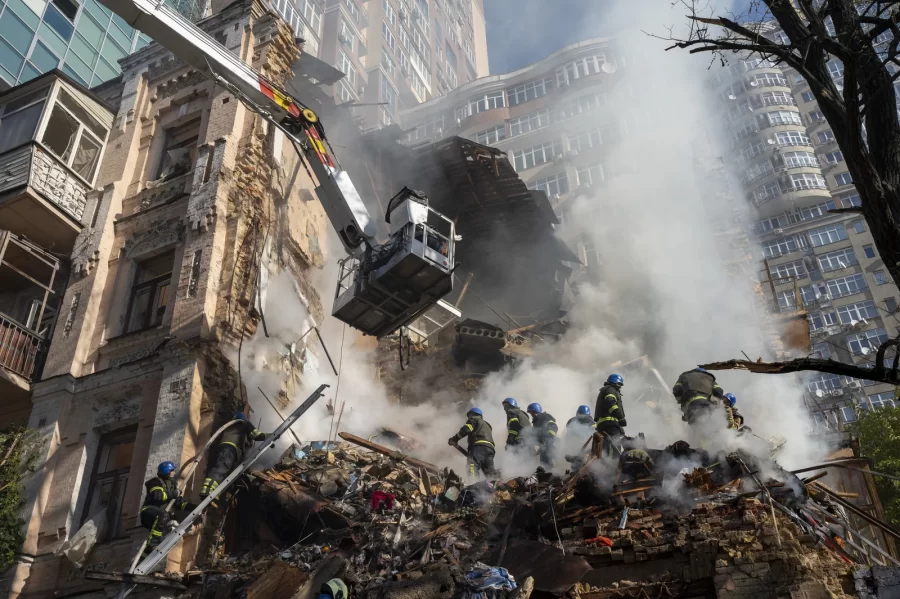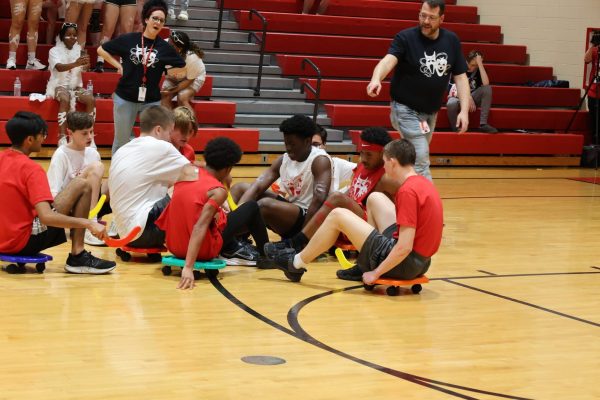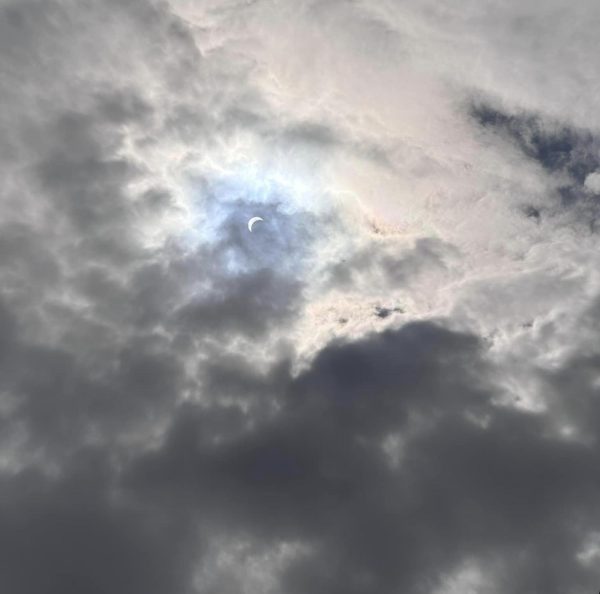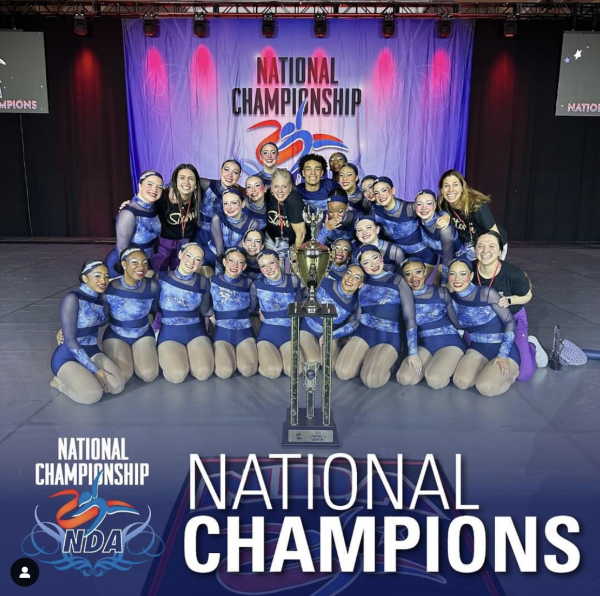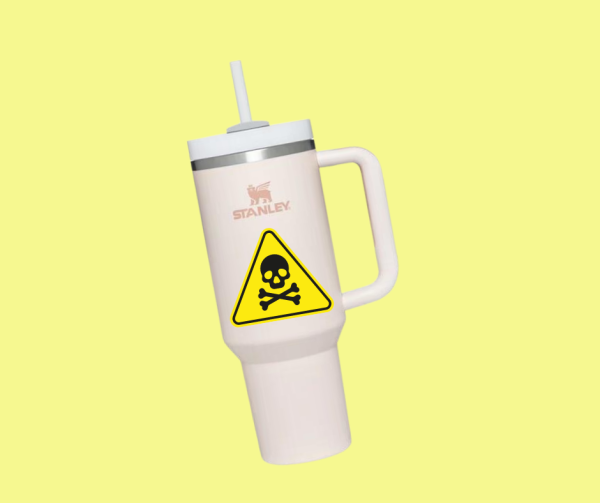“Our flag will be everywhere”: Russo-Ukrainian war escalates as the Ukrainian counter offensive continues
Russia’s efforts in Ukraine appear to be descending into chaos as thousands flee the country to avoid recruitment
Photo courtesy of NPR (Roman Hrytsyna/AP)
Firefighters work after a drone attack on buildings in Kyiv, Ukraine, on Monday.
October 18, 2022
Ukrainian ground units successfully recaptured the town of Lyman in eastern Ukraine on October 1, hampering Russian logistics in the region. The ongoing conflict in Ukraine continues to be violent and locked in a game of tug-of-war over certain regions.
Units of the Ukrainian Armed Forces surrounded and captured the town of Lyman from Russian forces after a brief battle. Lyman is of strategic importance, being a major railroad hub that was used by Russia to supply its forces in the Donetsk Oblast in eastern Ukraine with fuel and ammunition since its capture on May 27. The recapture of Lyman by Ukrainian forces puts limits on Russia’s ability to maintain control over its occupied territories in the Donetsk region, and could allow for future Ukrainian offensive operations in that area.
“The Ukranians are making progress,” said Secretary General of NATO Jens Stoltenberg. “[They] are able to push back the Russian forces because of their courage, their bravery, and their skills.”
The liberation of Lyman is the latest victory of Ukraine’s Kharkiv Oblast counteroffensive, which began on September 6 and has put Russia into a general retreat in northern Ukraine. The success of the counteroffensive can be attributed to a Ukrainian deception campaign that deceived Russian military leadership into believing Ukraine would attack in the southern Kherson Oblast. Many elite Russian units were moved to the south to counter the potential Ukrainian assault, leaving the site of the actual Ukrainian counteroffensive in the north poorly defended.
Ukraine’s tenacity in the war thus far has come as a surprise to many. The war, which was originally expected by military analysts to be a swift victory by Russian forces, has instead bogged down into an extended conflict, with Russia struggling to keep the upper hand.
Russia is supposed to be this all-powerful country, but ordinary Ukrainian civilians are able to hold their ground against them
— sophomore Sydney Miller
“Russia is supposed to be this all-powerful country, but ordinary Ukrainian civilians are able to hold their ground against them,” said sophomore Sydney Miller.
The continued Ukrainian resistance has caused concern for military officials in Moscow, with many demanding Russian president Vladimir Putin find a way to win the war quickly. In an attempt to regain the initiative in the war and replace casualties, Russia announced partial mobilization (draft) on September 21.
In a televised address to the Russian people, Putin defended his decision, stating, “To ensure the security of our nation and people at the liberated territories, I consider it necessary to the Defense Ministry’s and General Staff’s proposal to hold partial mobilization.”
The draft is set to press over 300,000 Russian citizens into the Russian military, signaling a major escalation of the conflict. The draft has met widespread resistance, with many choosing to flee to neighboring countries such as Kazakhstan or Turkey to avoid being drafted. It is estimated that over 700,000 Russians have fled in wake of the draft. Anti-war protests in Russia have also increased in response to the new policy from Moscow.
An October 16 article in the New York Times emphasizes the chaotic recruitment of “thousands of newly drafted, untrained, ill-equipped soldiers to Ukraine…desperate to plug holes in its defensive lines to mold the men into cohesive units.” As a result, “coffins are already coming” back to Russia, since poorly trained recruits are unable to hold the line or execute important military offensives.
In an attempt to generate a legitimate justification for their continued operations in Ukraine, Russia annexed four Ukrainian oblasts in the Donbas on September 30, after staging referendums in those territories. The annexation is the largest since the Second World War. The results of the referendums and the annexation have been considered illegitimate and have not been recognized by any other nation.
“The annexation of the Donbas is just another example of Putin’s abuse of power,” said senior Eric Wenz. “It’s his shameful attempt to legitimize the Russian invasion.”
The annexed territories themselves are not fully controlled by Russia, and are being actively contested as part of Ukraine’s counteroffensive. Regardless, Russia now considers the fighting in Ukraine to be on rightful Russian soil, and Putin has stated that Russia would defend the land by “all available means.” Putin has also threatened to use nuclear weapons if Ukraine does not step down and return to the negotiating table. However, Ukrainian president Volodymyr Zelensky remains undeterred.
“Russia has staged a farce in Donbas. An absolute farce, which it wanted to present as an alleged referendum,” said Zelensky in an official video. “Ukraine will return its own. Both in the east and in the south. And what they tried to annex now, and Crimea, which has been called annexed since 2014. Our flag will be everywhere.”
While Ukraine has garnered international support, many cities, including the capitol, Kyiv, continue to see massive destruction. Russia launched two consecutive strikes on the capitol last week, one via drone attack, injuring dozens and killing at least four.
The ongoing conflict has disrupted international markets, displaced millions and killed thousands.

